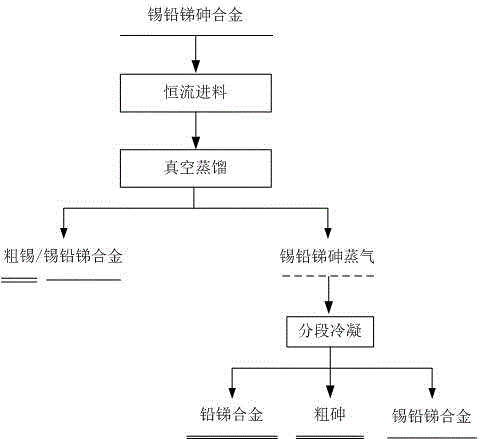Method for separating tin from tin-lead-stibium-arsenic alloy by vacuum distillation
A technology of distillation separation and antimony alloy, which is applied in the direction of improving process efficiency, etc., can solve the problems of poor antimony volatilization effect, difficult treatment, and restriction of antimony volatilization, and achieve simple equipment, high universality of raw materials, and no discharge of three wastes Effect
- Summary
- Abstract
- Description
- Claims
- Application Information
AI Technical Summary
Problems solved by technology
Method used
Image
Examples
Embodiment 1
[0015] Such as figure 1 Shown, the method for separating tin by vacuum distillation of the tin-lead-antimony-arsenic alloy, its specific steps are as follows:
[0016] Step 1. First, 82t of tin-lead-antimony-arsenic alloy whose composition is Sn68.58wt.%, Sb27.3wt.%, Pb3.2wt.%, As0.6wt.% is melted at a temperature of 420~520°C;
[0017] Step 2. The tin-lead-antimony-arsenic alloy liquid obtained in step 1 is continuously and stably fed into the vacuum furnace at a rate of 7 tons per day by using the constant-current feeding method. The vacuum degree of the vacuum furnace is controlled to 5Pa, and the distillation temperature is 1450-1500°C for vacuum distillation , to obtain 55.16 tons of crude tin products containing Sn98.7wt.%, Sb0.65wt.%, Pb0.09wt.%, As0.04wt.% in the residual substance and the tin-lead-antimony-arsenic alloy metal vapor entering the condenser, and the condenser It is divided into 3 sections to condense the metal vapor of the tin-lead-antimony-arsenic allo...
Embodiment 2
[0020] Such as figure 1 Shown, the method for separating tin by vacuum distillation of the tin-lead-antimony-arsenic alloy, its specific steps are as follows:
[0021] Step 1. First, 49.46 tons of tin-lead-antimony alloy whose composition is Sn25.9wt.%, Sb47.5wt.%, Pb23.4wt.%, As3.0wt.% are melted at a temperature of 560~650°C;
[0022] Step 2. Send the tin-lead-antimony-arsenic alloy liquid obtained in step 1 continuously and stably into the vacuum furnace at a rate of 12 tons per day by using the constant-current feeding method. Control the vacuum degree of the vacuum furnace to 10 Pa, and carry out vacuum distillation at a distillation temperature of 1000-1150 °C , obtain the residue containing Sn78.5wt.%, Sb19.6wt.%, Pb1.03wt.%, As0.3wt.% tin-lead-antimony alloy 17.41 tons and enter the tin-lead-antimony-arsenic metal vapor in the condenser, the condenser It is divided into two stages to condense the metal vapor of the tin-lead-antimony-arsenic alloy, and the temperature ...
Embodiment 3
[0027] Such as figure 1 Shown, the method for separating tin by vacuum distillation of the tin-lead-antimony-arsenic alloy, its specific steps are as follows:
[0028] Step 1. First, melt 56.4t of tin-lead-antimony-arsenic alloy whose composition is Sn2.92wt.%, Sb5.88wt.%, Pb90.68wt.%, As0.32wt.% at a temperature of 300~350°C;
[0029] Step 2. Send the tin-lead-antimony-arsenic alloy liquid obtained in step 1 continuously and stably into the vacuum furnace at a rate of 14 tons per day by using the constant-current feeding method. The vacuum degree of the vacuum furnace is controlled to 2Pa, and the distillation temperature is 1150-1200°C for vacuum distillation , the residue containing Sn67.64wt.%, Sb21.71wt.%, Pb9.91wt.%, As0.07wt.% tin-lead-antimony alloy 2.32 tons and the tin-lead-antimony-arsenic alloy metal vapor entering the condenser will be condensed The condenser is divided into two sections to condense the metal vapor of the tin-lead-antimony-arsenic alloy. The temp...
PUM
 Login to View More
Login to View More Abstract
Description
Claims
Application Information
 Login to View More
Login to View More - Generate Ideas
- Intellectual Property
- Life Sciences
- Materials
- Tech Scout
- Unparalleled Data Quality
- Higher Quality Content
- 60% Fewer Hallucinations
Browse by: Latest US Patents, China's latest patents, Technical Efficacy Thesaurus, Application Domain, Technology Topic, Popular Technical Reports.
© 2025 PatSnap. All rights reserved.Legal|Privacy policy|Modern Slavery Act Transparency Statement|Sitemap|About US| Contact US: help@patsnap.com

